Temples of Tamil Nadu
Tamil Nadu is known as the 'land of temples'. There are more than 30,000 temples in Tamil Nadu built by various dynasties. Tamil Nadu reflects early Dravidian art and culture, characterized by ornamented temples with soaring towers known as gopuras.
These temples share the same physical features like the gopuram over the entrance gates on all the four directions, the vimana, the tower over the sanctum and the spacious halls and corridors.
The temples were not just a place of worship and were a place for social gathering, education and celebration. The temples also acted as the storehouses for emergencies and many a temple also maintained hospitals. The art and craft flourished and was encouraged in the temples. Art was performed in all the forms, i.e., music, dance, drama and handicrafts.
Ranganathaswamy Temple, Srirangam
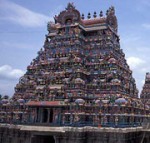 The Ranganathanswamy temple complex is about three km from the Rock Fort at Srirangam in Trichi. 7 concentric walls with 21 gopuras surround the temple. The temple was constructed by many dynasties including the Cheras, Pandyas, Cholas, Hoysalas and Vijayanagar Empire and the date of its construction ranges from the 14th to 17th centuries AD.
The Ranganathanswamy temple complex is about three km from the Rock Fort at Srirangam in Trichi. 7 concentric walls with 21 gopuras surround the temple. The temple was constructed by many dynasties including the Cheras, Pandyas, Cholas, Hoysalas and Vijayanagar Empire and the date of its construction ranges from the 14th to 17th centuries AD.
The largest gopuram of the temple is in the first wall on the southern side, which is the main entrance and was completed in 1987. It rises to a height of 73 m. the main temple is dedicated the Lord Vishnu although there are several other shrines dedicated to various gods and goddesses.
An annual Rath Yatra in a decorated wooden chariot is held in the month of January. The Vaikuntha Ekadasi or the Paradise festival is organized somewhere in the middle of December. The non-Hindus are allowed only till the sixth wall and not inside the gold- finished sanctum.
Srivaikunthanthor Temple, Tirunelveli
The Srivaikunthanathor Temple is 37 km away from Tirunelveli. It is also known as Kallapiranswami temple and was used as a fort during British period. It is dedicated to the Lord Vishnu and has majestic gopurams. This is an ancient temple known for its enchanting icons. The mandapas with pillars is embellished with sculptures of yallis, elephants and warriors. The Ekadasi Mandap contains elegant carvings and is open on Vaikuntha Ekadasi. It is one of the 108 Sri Vaishnavite sacred shrines and has been sung by the Alwar Saints.Ramalinga Temple, Chidambaram
The Ramalinga temple is in the center of Chidambaram spreads over an area of 40 acres. It is dedicated to the Lord Shiva in the form of Ramalinga or Ramananda. The significant feature worth watching in the temple is the thousand-pillar hall.Nataraja Temple, Chidambaram
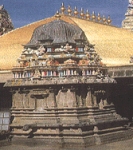 The Nataraja Temple at Chidambaram is 200 km from Chennai. Chidambaram is popular as the 'City of the Cosmic Dancer'. The Nataraja temple is an example of the Chola Architecture and covers an area of 40 acres. The temple is a dedicated to the Dancing Form of Shiva in the form of the Lord Nataraja. The temple is a tribute to the art of Bharatnatyam.
The Nataraja Temple at Chidambaram is 200 km from Chennai. Chidambaram is popular as the 'City of the Cosmic Dancer'. The Nataraja temple is an example of the Chola Architecture and covers an area of 40 acres. The temple is a dedicated to the Dancing Form of Shiva in the form of the Lord Nataraja. The temple is a tribute to the art of Bharatnatyam.
The presiding deity of the temple is represented by the vacuum space, which is one of the five elements of the universe, the others being wind, water, fire and earth. It is known as the Akasa Lingam. The temple has the statue of Nataraja made in bronze, famous all over the world as the absolute synthesis in the metal art. The pillars in the eastern tower of the temple depict the Lord Nataraja in 108 different poses of the classical dance of Bharatnatyam. The temple has a striking roof covered with gold.
The Natyanjali festival is dedicated to Lord Shiva and is celebrated every year during the months of February-March. The festival continues for five days with in the temple premises. The dance festival begins on the auspicious day of the Maha Shivaratri.
Meenakshi Temple, Madurai
The original Meenakshi Temple was built by Kulasekara Pandya and is dedicated to Lord Shiva. Shiva and his consort Parvati are known here as Sundareshwara and Meenakshi. The temple was converted into a magnificent structure by the nayaks, who ruled Madurai from the 16th to the 18th century AD.According to local legends, Malayadwaja Pandya was the king of Madurai. He did not have any child for a long time so he performed a many yagnas or the sacrifices made before a sacred fire. On one of the sacrifices, a three-year-old girl came out of the fire and Malayadwaja adopted her. The girl had three breasts, which was the reason of worry for Malayadwaja. However, a divine voice gave assurance to him that the third breast would disappear as soon as she met her consort. The girl became a brave and beautiful princess and won many battles.
She finally lost her heart to Lord Shiva, when she met him on the battlefield in Kailash. Herr third breast disappeared as soon as she saw him and recognized her divine consort. They ruled over the Pandya kingdom for some time and then settled in the Meenakshi temple at Madurai as Meenakshi and Sundareshwara.
High walls enclose the temple complex. There are two sanctums of Sundareshwara and Meenakshi in the center of the complex. The two sanctums are surrounded by a number of smaller shrines and grand pillared halls. The 12 gopuras of the temple are really impressive. The towers rise from solid granite bases and are adorned with stucco figures of the deities, mythical animals and grotesque figures painted in bright colors
Kumari Amman Temple, KanyaKumari
The Kumari Amman Temple overlooks the shores from KanyaKumari. The place KanyaKumari got its name from the Goddess KanyaKumari Amman who is the popular deity of this area.According to the legends, the goddess Parvati did penance in this place to obtain lord Shiva as her husband. When she was not successful in her penance, she vowed to remain virgin. Thus the temple is dedicated to Parvati in the form of Devi Kanya, the virgin goddess. the idol of the goddess Parvati has a sparkling diamond on her nose, which is supposed to outshine the sea.
The non-Hindus are not allowed to enter the temple. The temple opens from 0430 hrs to 1130 hrs in the morning and from 1730 hrs to 2030 hrs in the evening.
Kapaleshwarar temple, Mylapore
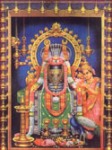 The Kapaleshwarar temple is 8th century AD temple but has a contemporary structure. The construction of the temple is based on the descriptions in the Puranas and the Tevaram. The gopuram of the temple is made in typical Dravidian style of architecture. The temple is dedicated to the Lord Shiva.
The Kapaleshwarar temple is 8th century AD temple but has a contemporary structure. The construction of the temple is based on the descriptions in the Puranas and the Tevaram. The gopuram of the temple is made in typical Dravidian style of architecture. The temple is dedicated to the Lord Shiva.
A lofty Rajagopuram with several stucco images decorates the Eastern entrance to the temple. The sanctum is located here facing the West direction where the temple tank is located. The huge temple tank is the place for the popular Teppam or the Float festival celebrated in the month of Thai, i.e., Capricorn.
Parvati or Karpakambal is said to have worshipped Shiva here in the form of a peacock, Mayil. Hence the place got the name as Mylapore. In the courtyard of the temple, a small shrine of goddess Parvati depicted as peacock is worshipped under an old Punnai tree.
The Arupattu Moovar festival is celebrated every year in the months of March-April.There are several literary works related with this age-old shrine. It is a seat of Tamil culture today.
Vivekananda Memorial, KanyaKumari
The Vivekananda Memorial at KanyaKumari is 500 m away from the main land. It stands on one of the two rocks separated from each other by 70 m. the Memorial is dedicated to Swami Vivekananda, one of the most charismatic spiritual leaders of this century, who is said to have meditated on this rock. The Rock memorial is a unique structure built in 1970 and has a meditation hall. The design of the mandapa is a blend of various architectural styles of India. the statue of Swami Vivekananda is also placed over here.Poompuhar Shipping Corporation operates frequent ferry services from the shore to the rock memorial at regular intervals. The Memorial is open from 700 hrs to 11 hrs in the morning and from 1400 hrs to 1700 hrs in the evening. It is closed on Tuesday.
Nellaiappar Temple, Tirunelveli
The Nellaippar temple is at a distance of 1 km from Tirunelveli Junction. The temple is dedicated to Lord Nellaiappar. This temple has a shrine of Lord Shiva and Parvati spanning over an area of 14. Shiva is said to have been worshipped by Agastya in a bamboo grove and by Rama after having killed Mareecha some nine miles away at Manoor.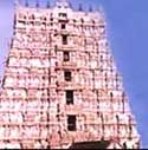
The antiquity of the temple dates back to 700 AD and has been sung by the Shaivite saint Tirugnana Sambandar. The musical pillars in the Mani Mandapam produces sound in various pitches when struck. the Samovar Mandapa or the 1000 pillared hall and the Tamra sabha with intricate woodwork and the Vasantha Mandapam are some of the noteworthy features of this temple. realistic sculptures decorate several mandapas of the temple. the finest specimen of this is Sangili Mandapam, which links the two temples of Nellaiappar and Kantimathi in this vast temple complex.
The historicity of the town tells that the town was known as Venuvanam. The Lord Shiva wanted to test the devotion of Vedapattar, Shiva's devotee. Lord made him lose all his wealth and suffer. Still, Venuvanam did not give up regular praying to God. One day, Vedapattar left some paddy in the sanctum of the temple and went to take a bath in the river. It started pouring in the meantime. Vedappatar came running to the sanctum to save the paddy. He was surprised to see the rain did not affect the paddy as the God had put a fence around it.
Nagaraja temple, Nagercoil
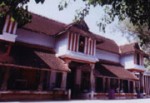 The Nagaraja temple situated at Nagarcoil is dedicated to the Lord Nagaraja. Nagercoil got its name from the five headed serpent shrine of the Nagaraja. Besides the presiding deity, the idols of Lord Shiva and Anantha Krishna are also enshrined in the ardhamandapa of the temple. the figures of Jain Thirthankaras Parsavanth and Mahavira are carved on the pillars of the mandapa.
The Nagaraja temple situated at Nagarcoil is dedicated to the Lord Nagaraja. Nagercoil got its name from the five headed serpent shrine of the Nagaraja. Besides the presiding deity, the idols of Lord Shiva and Anantha Krishna are also enshrined in the ardhamandapa of the temple. the figures of Jain Thirthankaras Parsavanth and Mahavira are carved on the pillars of the mandapa.
The entrance gateway of the temple, Mahamerumaligai, resembles the Chinese architecture of Budha Viharas. Thus the temple is an embodiment of the four religious creeds of India namely, Shaivism, Vaishnavism, Jainism and Buddhism.
The unique feature of the temple is that mud walls surround the sanctum and a simple thatched roof with coconut leaves and bamboo sticks over it. The place where the image of the five-headed serpent is enshrined is constantly marshy. The sand scooped out of this place is distributed to the devotees as prasadam. There are a plenty of cobras found inside the temple.
Kailashnath Temple, Kanchipuram
The Kailashnath temple situated at Putleri Street 1.5 km from Kanchipuram. is an ancient temple fine specimen of the Pallava architecture. The Pallava king Rajasimha started the temple in the 7th century AD and was completed by his son Mahendra. It is the oldest structure in Kanchipuram and the finest example of Pallava architecture in South India. The foundation of the temple is made of granite while the superstructure is carved out of sandstone.The circumambulatory path around the sanctum is made in such a manner that it requires visitors to climb the up and down a flight of seven stairs and to crawl through narrow ways.
The temple is adorned with the sculptures of the Lord Shiva in 64 poses, which presents a picture of different aspects of mythology. The fresco paintings embellish the inner walls of the shrine. The temple is unique in its architecture and is viewed more as an architectural wonder than as a holy place.
It is not a major pilgrimage center. Pujas are offered regularly here to the Lord Shiva-Kailashanatha. The festival of Shivaratri is held here once every year.
 Varadaraja temple, Kanchipuram
Varadaraja temple, Kanchipuram
The Varadaraja temple is situated 3 km to the south of Kanchipuram. The temple is also known as the Devarajaswamy Temple. Originally it was known as Attiyuran.
It is one of the important Vaishnavite shrines. The main deity is the Lord Vishnu in the form of the Lord Varadaraja Perumal. The idol of the deity is in the standing posture facing towards the east. The temple is known for its splendid art and had association with Sri Ramanuja who used to serve here. The100 pillar mandapa of the temple beautifully carved. The gopuram of the temple is 100 ft high and originally built in 11th century AD. The Vijyanagar Kings renovated it after 500 years.
Brihadeswara Temple, Thanjavur
The Brihadeswara temple at Thanjavur is within a huge compound with walls rising above 15m. The temple is made over a 29 m square base and has a soaring vimana and a stunted gopuram. The inner sanctum and the gopuram were constructed over a period of 12 years. It was constructed from a single piece of granite weighing around 80 tonnes. The dome was hauled into place along a 4-km earthwork ramp in a manner similar to the Egyptian pyramids.
The lofty sanctum tower known as the Srivimana, is enclosed by a rectangular prakara or corridor consisting of two squares. The main tower occupies the center part of the rear square, with the center vimana or tower having 16 tiers, which rises to a height of 200 ft. The tower is considered to be symbolic of the mountain Meru. Several stucco features also decorate the vimana.
The inner wall of the sanctum has sculpted 108 dance poses called karmas performed by Lord Shiva himself. The Shiva lingam is called Peruvudaiya, Rasjarajeshwaramudvya. It is a huge lingam, which is set in a two-storeyed sanctum. Rajaraja Chola crowned it with 12.5 ft tall finial of 9.25 kilograms of choppers plated with 800 grams of gold.
A huge statue of Nandi measuring 6 m length and 3.7 m in height faces the inner sanctum. The statue of Nandi was created from a single rock piece and weighs 25 tonnes. It is in fact one of the largest statues of Nandi bulls in India. The temple also has a spacious ground, number of pillared halls, shrines and 250 lingams.
Thanumalayam Temple, Suchindram
 The Thanumalayan temple is situated at Suchindram in KanyaKumari. The temple is dedicated to the three Gods, Shiva, Vishnu and Brahma. The deity of the temple is the representation of the combined forces of Brahma, Vishnu and Shiva.
The Thanumalayan temple is situated at Suchindram in KanyaKumari. The temple is dedicated to the three Gods, Shiva, Vishnu and Brahma. The deity of the temple is the representation of the combined forces of Brahma, Vishnu and Shiva.
The temple has a beautiful gopuram and inscriptions of the 9th century are found in this temple. The temple is a repository of art. It is famous for its musical columns and an impressive statue of Hanuman, which is 3 m tall. The musical pillars and the huge statue of Hanuman are the evidence of the artistic prowess of the artists of that time.
It is believed that Shiva started from this very place to wed KanyaKumari Amman, but returned when he saw the first day of the light.
Some of the Major Architecture in Ancient & Medieval Times in India
Contribute More Facts